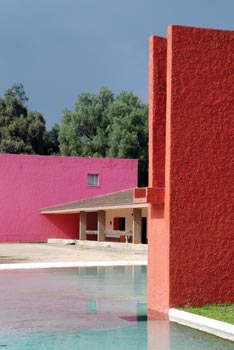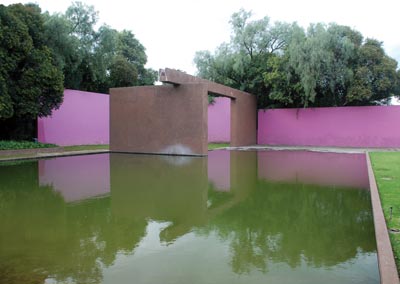When walking into the main room of the house of Mexican architect Luis Barragan (1902-1988), one has the certainty of having been benefitted with a mystic revelation: being there, surrounded by his personal belongings, his favorite chair, his library, makes one feel and understand the rare quality of his architecture, which was built on dualities and ambivalences. It is, at the same time, solid and immaterial, heavy and ethereal, abstract and figurative, symbolic and concrete, peaceful in presence but dynamic in function, full of traditional references, but certainly absolutely modern. It is its own voice and echo of other previous voices. His house, like famous convent-fortresses of 16th century’s Mexico, is a home and something more: it’s both a shelter and a fort protecting people not only from the open air, but particularly from the many aggressions of the contemporary city and life; a dwelling effectively designed to defend and safeguard the privacy and peace of mind of its dweller.
 That cozy, nearly magic inner space, after admiring an architectural engraving by Jose Clemente Orozco, lit by the light coming from the garden through a big glass window whose joints form a cross –clear reference to the Mexican religiosity–, reminds us of the architect’s preferred concepts and confirms his views of duality: a house must look like a garden, and a garden must look like a house. In that space, one can enjoy a phenomena rarely achieved with such mastership in modern architecture: that is, the perfect dissolution of boundaries and barriers between interior and exterior spaces, without any of them losing their essence. The same happens at the end of the tour in the residence’s rooftop courtyard: one can walk on the highest level of the building without getting to see the city surroundings: the only possible field of vision is vertical, upward, and the only thing to appreciate is the changing landscape of the sky framed by the high, colorful and textured walls around the building, which makes us think again of the idea of protection and isolation and mentally takes us from the avant-garde contemporary architecture back to traditional Mexican haciendas.
That cozy, nearly magic inner space, after admiring an architectural engraving by Jose Clemente Orozco, lit by the light coming from the garden through a big glass window whose joints form a cross –clear reference to the Mexican religiosity–, reminds us of the architect’s preferred concepts and confirms his views of duality: a house must look like a garden, and a garden must look like a house. In that space, one can enjoy a phenomena rarely achieved with such mastership in modern architecture: that is, the perfect dissolution of boundaries and barriers between interior and exterior spaces, without any of them losing their essence. The same happens at the end of the tour in the residence’s rooftop courtyard: one can walk on the highest level of the building without getting to see the city surroundings: the only possible field of vision is vertical, upward, and the only thing to appreciate is the changing landscape of the sky framed by the high, colorful and textured walls around the building, which makes us think again of the idea of protection and isolation and mentally takes us from the avant-garde contemporary architecture back to traditional Mexican haciendas.
Barragan was an eccentrics figure within modern architecture which partially explains his late international recognition. However, more than twenty years after it came, time confirmed the certainty with which the jury of prestigious Pritzker Prize decided to grant him the award prize in 1980: his work was unique within the architectural trends of the time, a lonely creator whose work, rich in intensity and meanings though not abundant in number, was set to survive the fickleness of fashion to become a permanent and essential reference of the best of Latin American artistic production of the 20th century.
The Pritzker Prize, frequently put at the same level as the Nobel Prize in other fields, became quickly after its creation in 1979 the most important and coveted prize for architects. The first Pritzker prizewinner was American Philip Johnson, which set a precedent for the acknowledgement that was recurrently –though not always fairly– granted to gleaming specialists from the “star system” mostly coming from the so-called “First World”. One can deduce from the fact that the second Pritzker Prize was awarded to a Latin American who was relatively unknown at the moment, how impressed members of the jury were to discover Barragan’s unprecedented work that excelled for its lyricism in a period ruled by postmodernist cynicism worldwide, imposing a language usually based on the superficial interpretation of history as oppose to the creative essence and deep search to unify modernity and tradition which defined Barragan’s architecture’s contents.
In his speech at the awards ceremony, read with elegant plainness and respectful humbleness, Barragan defined the fundamentals of his personal understanding of architecture leaving mesmerized not just a small group of specialists but the whole world architecture community, as he employed terms and concepts that had little to do with the ways of doing –firstly emptily abstracts, and then cloyingly figurative– that had developed since the 1940s until then. When structuring his theoretical speech as a sequence of words and definitions making up theoretical grounds that were apparently “outdated” though still totally valid to him, Barragan showed how his whole professional search starting from the lonely individuality of unclassifiable creators had served to only one supreme purpose: securing beauty, because as he said: a life deprived from beauty does not deserve to be called human.”1 Other concepts stated at the reception confirmed Barragan as an autonomous and exceptional creator: he spoke about religion and myth, the value of silence and solitude –“only in close communion with her can men find themselves,” he said–, of serenity and joy, death and nostalgia. His architecture is consequently built on intangible elements, although visually expressed through forceful planes, exquisite details, rough textures and intense colors. In his speech he made reference to only two physical, concrete –though full of symbolic evocations– components of his work: gardens and fountains, considered very important to him. Regarding the first one, Barragan thought that gardens most, as an undeniable condition, “unify the poetic and the mysterious with serenity and joy,” and he liked to mention Ferdinand Bac as a reference for this project and on his definition, quoting him as saying: “Gardens shelter the largest amount of serenity men can have.”
 In the water of the fountains, combined with the dense vegetation of his relaxed hardens and the thick walls of his elegant architecture, Barragan found his best allied for artistic creation. The water, being only one and at the same time constantly changing, enabled him to enhance the dual content of his works through the real and its double reflected on the liquid mirror in the fountains. The sensorial contemplative experience is complemented and sonorously completed with the murmur of the running, falling or rippling water creating, as the architect said, “a peaceful sensuality.” Barragan said cisterns of haciendas and well’s curbs in the convents’ courtyards were recurring elements in his dreams or childhood memories. It is from there, from his dreams and memories, that he took his architecture.
In the water of the fountains, combined with the dense vegetation of his relaxed hardens and the thick walls of his elegant architecture, Barragan found his best allied for artistic creation. The water, being only one and at the same time constantly changing, enabled him to enhance the dual content of his works through the real and its double reflected on the liquid mirror in the fountains. The sensorial contemplative experience is complemented and sonorously completed with the murmur of the running, falling or rippling water creating, as the architect said, “a peaceful sensuality.” Barragan said cisterns of haciendas and well’s curbs in the convents’ courtyards were recurring elements in his dreams or childhood memories. It is from there, from his dreams and memories, that he took his architecture.
Luis Barragan’s lifework represents a permanent quest of modernity through local traditions as shown from his first neocolonial works in the 1920s to his masterpieces built in the 1940s and paradoxically including the short rationalist period of the thirties. Another great Mexican, Nobel prizewinner for Literature Octavio Paz, once wrote: “In my peregrination in search of modernity I got lost and found myself many times. I returned to my origins and discovered that modernity is not outside but inside us.”2 These words may as well define the poetic traced by Barragan in his own search of modernity from creative solitude, shielded in the austere silence of deep meditation and using, as raw material, the echoes of the voices of his forefathers.
1All quotations from Barragan were taken from his speech of acceptance of the Pitzker Prize in Dumbarton Oaks, Washington, D.C., in 1980.
2 Taken from Octavio Paz’ speech of acceptance of the Nobel Prize for literature in 1990.
Related Publications

How Harumi Yamaguchi invented the modern woman in Japan
March 16, 2022












